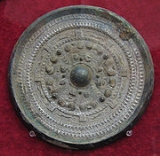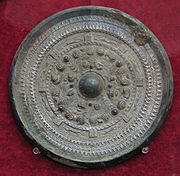
Shinju-kyo
Encyclopedia
Japanese is an ancient type of round bronze mirror
decorated with images of gods and animals from Chinese mythology
. The obverse side has a polished mirror and the reverse has relief representations of legendary Chinese shen (神 "spirit; god"), Xian
(仙 "transcendent; immortal"), and legendary creatures.
 The shinjūkyō style of bronze mirror originated in China and was frequently produced during the Han Dynasty
The shinjūkyō style of bronze mirror originated in China and was frequently produced during the Han Dynasty
, Three Kingdoms
, and Six Dynasties
(1st-6th centuries CE). With the spread of Chinese bronze casting technology, shinjūkyō were also produced in Japan and the Lelang Commandery
and Daifang Commandery
in Korea. The ca. 297 CE Wei zhi (魏志 "Records of Wei"), which is part of the Sanguo zhi (三國志 "Records of the Three Kingdoms"), has the first historical reference to bronze mirrors in Japan. It chronicles tributary relations between Queen Himiko of Wa (Japan)
and the Wei court, and records that in 239 CE, Emperor Cao Rui
sent presents to Himiko, including "one hundred bronze mirrors" (tr. Tsunoda 1951:15).
Archeological excavations of Japanese tombs from the Kofun period
(3rd-7th centuries CE) have revealed numerous shinjūkyō, and Japanese archeologists divide them into subtypes including:
Kurotsuka kofun
tomb excavated in Nara Prefecture
contained 33 sankakuen-shinjūkyō bronze mirrors. Some scholars (Edwards 1998, 1999, Nishikawa 1999) believe they are the original mirrors that Emperor Cao Rui presented to Queen Himiko, but others disagree.
Bronze mirror
Bronze mirrors preceded the glass mirrors of today. This type of mirror has been found by archaeologists among elite assemblages from various cultures, from Etruscan Italy to China.-History:-Egypt:...
decorated with images of gods and animals from Chinese mythology
Chinese mythology
Chinese mythology is a collection of cultural history, folktales, and religions that have been passed down in oral or written tradition. These include creation myths and legends and myths concerning the founding of Chinese culture and the Chinese state...
. The obverse side has a polished mirror and the reverse has relief representations of legendary Chinese shen (神 "spirit; god"), Xian
Xian (Taoism)
Xian is a Chinese word for an enlightened person, translatable in English as:*"spiritually immortal; transcendent; super-human; celestial being"...
(仙 "transcendent; immortal"), and legendary creatures.

Han Dynasty
The Han Dynasty was the second imperial dynasty of China, preceded by the Qin Dynasty and succeeded by the Three Kingdoms . It was founded by the rebel leader Liu Bang, known posthumously as Emperor Gaozu of Han. It was briefly interrupted by the Xin Dynasty of the former regent Wang Mang...
, Three Kingdoms
Three Kingdoms
The Three Kingdoms period was a period in Chinese history, part of an era of disunity called the "Six Dynasties" following immediately the loss of de facto power of the Han Dynasty rulers. In a strict academic sense it refers to the period between the foundation of the state of Wei in 220 and the...
, and Six Dynasties
Six Dynasties
Six Dynasties is a collective noun for six Chinese dynasties during the periods of the Three Kingdoms , Jin Dynasty , and Southern and Northern Dynasties ....
(1st-6th centuries CE). With the spread of Chinese bronze casting technology, shinjūkyō were also produced in Japan and the Lelang Commandery
Lelang Commandery
Lelang was one of the Chinese commanderies which was established after the fall of Gojoseon in 108 BC until Goguryeo conquered it in 313. Lelang Commandery was located in the northern Korean peninsula with the administrative center near modern P'yongyang....
and Daifang Commandery
Daifang Commandery
Daifang Commandery was one of the remnants of the Four Commanderies of Han in the Korean peninsula.-History:Gongsun Kang, a warlord in Liaodong, separated the southern half from the Lelang commandery and established the Daifang commandery in 204 to make administration more efficient...
in Korea. The ca. 297 CE Wei zhi (魏志 "Records of Wei"), which is part of the Sanguo zhi (三國志 "Records of the Three Kingdoms"), has the first historical reference to bronze mirrors in Japan. It chronicles tributary relations between Queen Himiko of Wa (Japan)
Wa (Japan)
Japanese is the oldest recorded name of Japan. Chinese, Korean, and Japanese scribes regularly wrote Wa or Yamato "Japan" with the Chinese character 倭 until the 8th century, when the Japanese found fault with it, replacing it with 和 "harmony, peace, balance".- Historical references :The earliest...
and the Wei court, and records that in 239 CE, Emperor Cao Rui
Cao Rui
Cao Rui , formally known as Emperor Ming of Wei, was the second emperor of the state of Cao Wei during the Three Kingdoms period of Chinese history. He was a son of Cao Wei's first emperor Cao Pi according to Liu Song dynasty historian, Pei Songzhi, but was a son of Yuan Xi according to modern...
sent presents to Himiko, including "one hundred bronze mirrors" (tr. Tsunoda 1951:15).
Archeological excavations of Japanese tombs from the Kofun period
Kofun period
The is an era in the history of Japan from around 250 to 538. It follows the Yayoi period. The word kofun is Japanese for the type of burial mounds dating from this era. The Kofun and the subsequent Asuka periods are sometimes referred to collectively as the Yamato period...
(3rd-7th centuries CE) have revealed numerous shinjūkyō, and Japanese archeologists divide them into subtypes including:
Kurotsuka kofun
Kofun
Kofun are megalithic tombs or tumuli in Japan, constructed between the early 3rd century and early 7th century. They gave their name to the Kofun period . Many of the Kofun have a distinctive keyhole-shaped mound , unique to ancient Japan...
tomb excavated in Nara Prefecture
Nara Prefecture
is a prefecture in the Kansai region on Honshū Island, Japan. The capital is the city of Nara.-History:The present-day Nara Prefecture was created in 1887, making it independent of Osaka Prefecture....
contained 33 sankakuen-shinjūkyō bronze mirrors. Some scholars (Edwards 1998, 1999, Nishikawa 1999) believe they are the original mirrors that Emperor Cao Rui presented to Queen Himiko, but others disagree.

